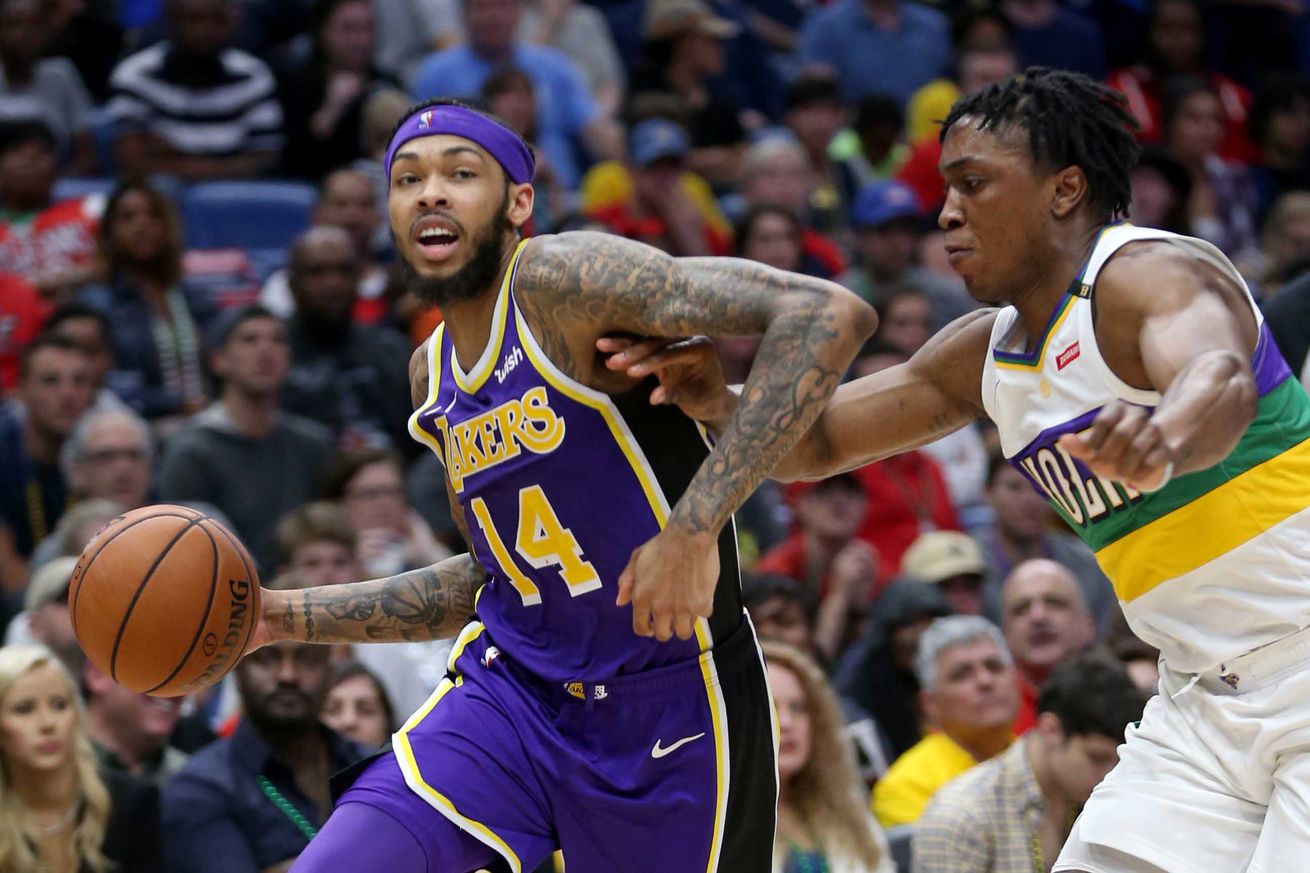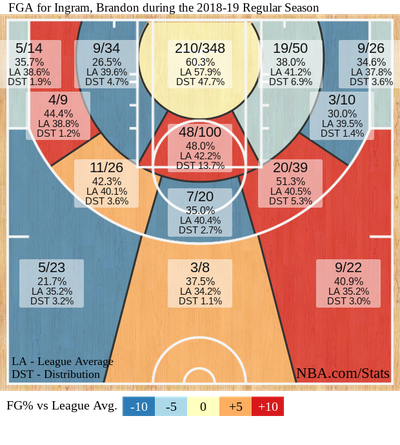MikeDelayo
Guest
Offline

You knew his name on the Lakers. Now, learn his game — which could take that proverbial next step with the Pelicans.
On Saturday, June 15th, the long-awaited Anthony Davis trade was finally reported by none other than ESPN’s Adrian Wojnarowski. This transaction will go down in the history books as The Anthony Davis Trade. If you are reading this you probably know a bit about who Anthony Davis is, and therefore that title makes a lot of sense. As a byproduct of this, the move cannot be known as The Brandon Ingram Trade, which also makes sense because you might not know much about Brandon Ingram. Maybe you knew he went to Duke once upon a time, was selected near the top of his draft, and spent his first three NBA seasons in Lakers purple and gold. If you didn’t, you do now, and by the end of this article you will hopefully know a little bit more.
Ingram was the youngest player in the 2016 NBA Draft class and was the second off the board after the Philadelphia 76ers selected Ben Simmons. When the 2019-20 season kicks off later this year, he will have just turned 22 in September, making him the second youngest non-2019 draftee on the Pelicans roster after Frank Jackson. A player that young usually has plenty of room to grow, but that does not mean what he has done on the court so far should be ignored.
Ingram has amassed 3.9 of his 4.5 career Win Shares while the ball belonged to the opposition, but to call him a “good defender” as result would probably get you whacked by The Waif. His -0.54 DRPM last season landed him in the bottom half of qualified small forwards at 55th out of 93. A slender 6’9” frame and 7’3” wingspan will forever provide chaos-agent potential on paper, but the havoc-wreaking on defense thus far has been minimal; of the 142 forwards who played at least 52 games in 2018-19, Ingram ranked 129th in deflections per 36 minutes with just 1.0.
At the very least, he has shown a knack for getting into the grill of shooters, and the further out of the paint the better. Shots from at least 15 feet away went in 3.4 percent less frequently when Ingram was there to contest, and the effect was even more pronounced on three-pointers, where opponents shot just 30.7 percent, 4.7 points lower than the 35.4 average. For reference, Kawhi Leonard lowered the effectiveness of these same shots by 2.1 and 3.1 respectively, and he is quite good! Kawhi does quite a few more basketball things better than Ingram and the rest of the NBA, because Kawhi can pretty much do all of the basketball things well. Nevertheless, this has been a legitimate strength of Ingram’s defense so far. After all, preventing points is the name of the game.
Unless, of course, you believe scoring points deserves that recognition instead. The book on Ingram’s offense is volatile, flipping from exciting and effective to inefficient and erratic depending on where you look.
Since his rocky rookie season, there have been a handful of marked improvements. His true shooting percentage (which takes free throws, two-point shots and three-point shots into account) has risen from an ugly 47.4 percent to 53.6 percent in 2017-18 to 55.5 percent last season, a mark that bests those put up by players like once-and-potentially-future King Harrison Barnes (55 percent) and Jayson Tatum (54.7 percent). That rise runs parallel to similar increases in overall field goal and free throw attempts as well as usage rate, a positive sign for his ability to shoulder sizable offensive responsibilities without sacrificing efficiency.
That 55.5 percent and his career-high 49.7 field goal percentage were anchored by Ingram’s concerted and successful effort to get to the basket as often as possible. More than a third (34 percent) of his attempted field goals came within three feet of the rim, and on those shots he shot 68.1 percent (the off-white area in the top-center of the chart below expands this range a bit).

The rest of his shot profile leaves a lot to be desired. He took more shots than ever between ten feet and the three-point line (34.5 percent of his field goal attempts), the dead zone of sorts for the modern NBA offense. Some orange and red (indicative of field goal percentages five and 10 percent higher than league average) can be found in that range, most notably at the elbows, but they are not bright enough. Making 103 of his 252 shots from that mid-range zone is good for a 40.9 percent success rate and just 0.81 points per shot, which is, in a word, bad.
Things have not been as dire behind the arc, but consistency has been lacking. In his sophomore campaign Ingram shot 39 percent from deep, but the seasons sandwiching that one featured marks of 29.4 percent and 33 percent, leaving his career average at a mediocre 32.9 percent.
In sharp contrast to his two-point makes, which have only been assisted 36.2 percent of the time throughout his career, 95.3 percent of his threes have come after a pass from a teammate. Granted, his 386 attempts are not a huge sample, especially considering 187 of them came in his rookie season, but he has clearly not been interested in creating off the dribble from deep. Here is the only pull-up three he attempted last season:
Considering this attempt was to beat the shot clock, N/A is probably the best designation in the pull-up category.
The annual uptick in his shooting percentages have correlated with significant drops in his three-point attempts. His 27.3 percent three-point rate as a rookie has plummeted to a career-low 12.9 percent in 2018-9, which is lower than what Anthony Davis managed in the same season. How his shot selection evolves in Alvin Gentry’s offense will be worth monitoring. He may never be better than average from three, but fewer mid range attempts may help his efficiency continue its improvement.
As important as scoring is to Ingram’s game, his most intriguing ability may be his playmaking. Mike Krzyzewski, his coach at Duke, occasionally allowed him to run the Blue Devils offense, and his willingness as a passer has remained intact. In 2017-18, he averaged a career-high 17.7 percent assist rate, which equated to 3.9 assists per game. With LeBron James on the roster, opportunities to run things through him were few in far between, but the willingness of Jrue Holiday and Lonzo Ball to share those initiation duties could lend themselves to more in the season to come.
It almost seems that whenever a highly-touted prospect hasn’t managed to put it all together, their believers cited a need for a change of scenery. That may have proven true for some in the past (think Victor Oladipo and Chauncey Billups), but Ingram’s need to get out of Los Angeles may be rooted more in fact than optimism. The basketball fit between he and James felt odd before they had even played a game together, and when combined with a tumultuous couple of seasons for the franchise before that, the apparent unhappiness comes as no surprise.
Prior to LeBron’s groin pull, Ingram was averaging 15.5 points, 4.0 rebounds and 2.2 assists. After James was sidelined for weeks following his Christmas Day injury, Ingram’s production shot up to a level of 20.5 points, 6.0 rebounds and 3.6 assists for the rest of the 2018-19 campaign. In addition, his shooting line improved from 47.1 FG%/31.0 3PT%/64.0 FT% to 51.4 FG%/34.6 3PT%/69.7 FT%.
A lot of what has been laid out is about what Ingram has done rather than what he can do alongside new teammates, and that is largely because the identity of those teammates is still up in the air. Regardless, there appears a really good player might be hiding inside Ingram’s body, one that is more likely to emerge now that he’s in New Orleans.
Continue reading...

